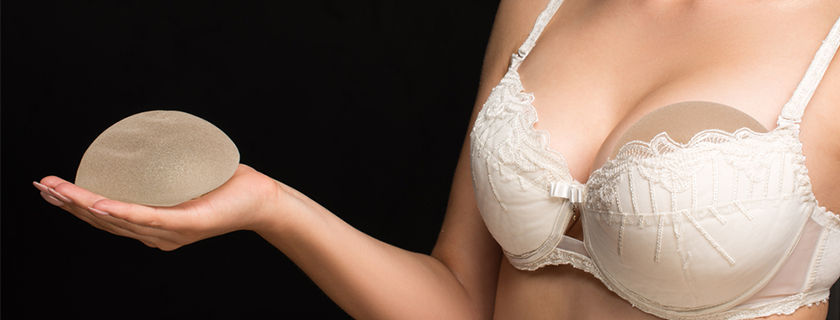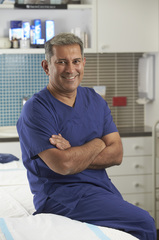
Choosing your implants is an important part of planning your breast augmentation. But which ones will you decide on? Dr Mark Hanikeri, Specialist Plastic Surgeon from Perth, helps us take a look at the different types of implants and how to identify which ones are right for you.
What are the different types of breast implants?
- Shape – round, teardrop
- Type of fill – silicone or saline
- Surface type – smooth or textured
- Size – generally referred to in cup sizes or cc’s
So, where do you start? How do you know which ones are right for you? Let’s look at the differences.
Different type of breast implant shapes – round or teardrop?
What do you want your breasts to look like? Where do you want the fullness? Dr Hanikeri says “round implants have advantages in some patients whilst teardrop have a distinct advantage in others. In the end, which is best is determined by what the patient is seeking from breast augmentation. Round implants are commonly used to restore the upper breast volume that may have been lost from breastfeeding or weight loss.” However he also goes on to say, “In very slim women who have very little of their own tissue or in women with mild sagging, round implants may produce a less natural appearance than teardrop shaped implants. This is especially the case if the implants have a high profile (high projection) or are placed in front of the pectoralis muscle.”
Teardrop implants give the lower section of the breasts more fullness. Dr Hanikeri says they produce a more natural slope from the collarbone down to the nipple. He also says, “For larger volume implants or in very slim women and those with slight sagging, they usually produce the most natural looking result over time. These implants do have the most cohesive (stiffest) silicone gel fill so they may feel firmer than other implants.”
Saline or Silicone Breast Implants (Or fat transfer!)
Saline implants are rarely used these days. They were used a lot more 20 years ago when it was difficult to use silicone filled implants in Australia. In fact, Silicone filled implants were difficult to use in the USA until a few years ago so much of the information on the internet and from American sites still talk about saline implants. Whilst they may well look the same, Saline filled implants have a greater tendency to rippling than silicone implants. In women with less of their own tissue, the implants can also feel quite unnatural. Though they can deflate, the exact rate of deflation is not known but when they do deflate, the saline is absorbed harmlessly into the body and the only issue is that the augmented breast shrinks back to it’s non augmented size.
Silicone implants are safe and there is no evidence linking silicone to any adverse health effects. They do still ripple though this tends to be less obvious than with saline filled implants. They feel very natural in most cases and are very durable over time. If the implants do rupture, with most modern implants it doesn’t cause any major issues since the silicone remains clumped together within the breast capsule.
Fat transfer is still not readily available in Australia since doctors are not automatically covered by their insurance companies to perform this procedure. It generally gives a smaller increase in size (up to one cup size), but can sometimes be significant enough for patient satisfaction. In some cases, more than one operation is needed to produce a noticeable increase in breast volume. The long term effects of fat grafting in breasts are still not known so some doctors do not offer this procedure. Fat grafting can also be used to fill up the soft tissues above an implant, especially when there is visible rippling or lack of upper pole volume. This procedure has no cover from health insurance companies so it can add significantly to the costs of breast augmentation.
Breast Implant Surface Type – Smooth VS Textured
Dr Hanikeri reminds us that smooth breast implants are the softest and more natural feeling. They also have a higher risk of bottoming out and drifting around in their new home! However there are also things to consider with textured breast implants. Dr Hanikeri explains, “Textured breast implants are designed to develop a capsule (scar tissue) that sticks to the implant, causing them to have less movement so they maintain their position better over time. Whilst this reduces the lateral drift and bottoming out, it can make the breasts feel less natural and if the tissues drop whilst the implant stays high, they may result in the “snoopy dog” or “waterfall” deformity that can sometimes occur when the breast tissues are deflated and droopy.” This is also more likely with round implants than teardrop implants since the round implants have the most projected point at a higher level than teardrop implants.
Lately there has been a lot in the media and internet about a rare type of lymphoma (Anaplastic Large Cell Lymphoma) that vary rarely occurs in women with breast implants (BIA-ALCL). This does not appear to occur in patients with smooth shell implants however the risk in patients with textured implants is also very low and generally should not impact the decision to use these implants in the majority of cases.
What breast implant size should I get?
This is the mother of all questions when it comes to breast implants. Many just want the most natural-looking breasts that are in proportion with their height, body frame and size. Others say “the bigger the better”. Sometimes with breast augmentation, “Less is more” in terms of the final result. While this is a hugely personal decision and you should do what you feel is right for you, just be aware that there are some disadvantages to having bigger implants, especially if you have a naturally smaller frame.
These can include:
- Less natural looking – the bigger and perkier they are, the less natural they look.
- A more difficult process for insertion – implants that are too large for the woman getting them may result in stiff, tight skin on their chests that looks unnatural.
- Body strain – implants that are too big for a woman’s frame can cause serious back, shoulder and neck pain. Having to hold up a massive weight all the time can take its toll on your body.
- Increased risk of “bottoming out” – this is where the implant drops below the breast pocket and needs a revision surgery.
- The bigger the implants the bigger risk of complications such as implant rippling, uniboob, excessive “side boob”, asymmetry and more
If you are unsure that the size you want is going to be right for you, express your wishes, desires and concerns with your surgeon and ask them for their expert opinion. Having said this, if you really don’t like what one surgeon says, you should get a second opinion (we always suggest having at least two or more consultations is beneficial for other reasons as well). If you find that every surgeon you consult with is saying the same thing, you might need to take their advice on board!
The Rice Test!
You can also do the “rice test” where you fill some stockings with various weights of rice and stuff them into your bra and walk around and wear them for a while to see what size implants might feel better for you. Remember, bigger implants may initially seem like a good idea at the time, but are you willing to lug them around for the rest of your life?!
Other considerations with type of breast implants include:
- Do you get your implants placed under or over the muscle?
- Where will your incisions and subsequent scars be? You should discuss this with your surgeon.
- Do you plan on breastfeeding in the future, after you have implants? This is an important question to answer and if you are planning on having children after a boob job, tell your surgeon so they can take every care to maximise your chances of still being able to breastfeed.
About Dr Hanikeri

It might seem that all breast implant options have risks and considerations, and in reality they do. Size? Shape? Under or over the muscle? Surface type? Fill? Discussing each and every option with an appropriately qualified and experienced surgeon such as Dr Mark Hanikeri will put you one step closer into getting the most awesome boobs for you.
If you’d like to arrange a consult with Dr Mark Hanikeri you can phone his clinic on (08) 9380 0311.
Further Reading Related to Breast Implant
- What Are the Most Natural Looking Breast Implants – Dr Watts Surgeon Perth
- History of Breast Implants and Breast Enlargement Surgery by Dr Carmen Munteanu
- Bra Cup Sizes related to Breast Implant Sizes – Dr Bish Soliman
- What Is the Right Implant Placement Option – Dr Michael Kernohan
- Types of Breast Implant Incisions by Dr Jake Lim
- Breast Implants Profile, Projection, Shape, Sizes and More
